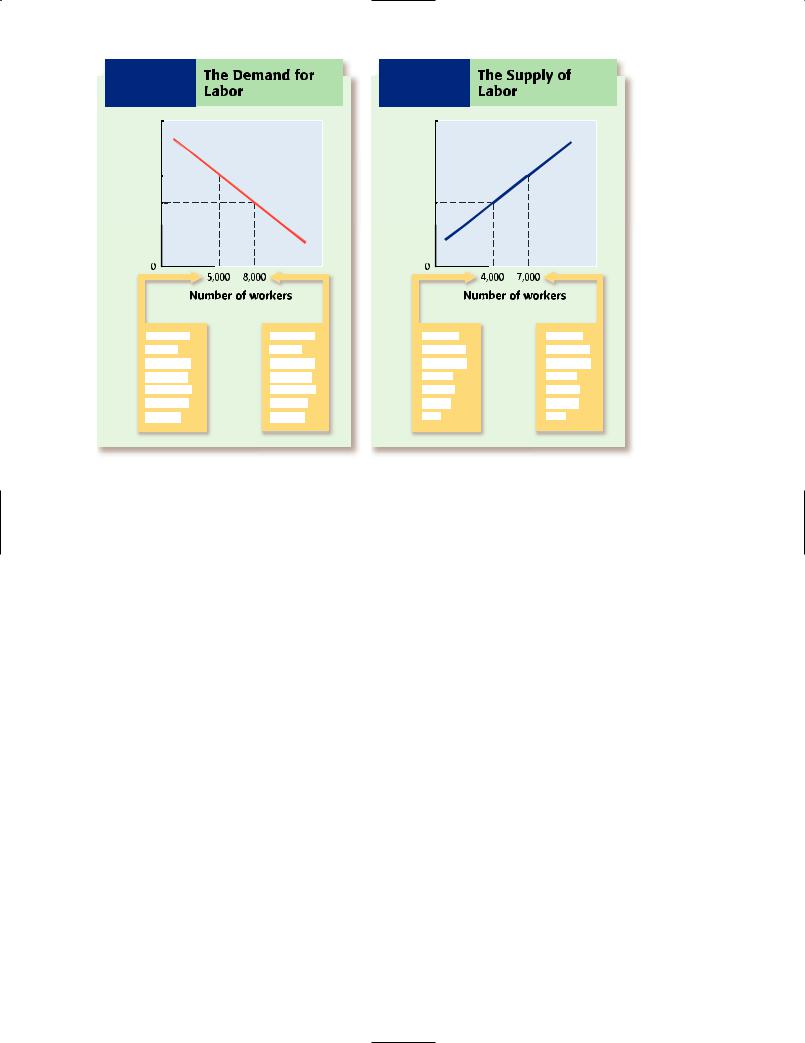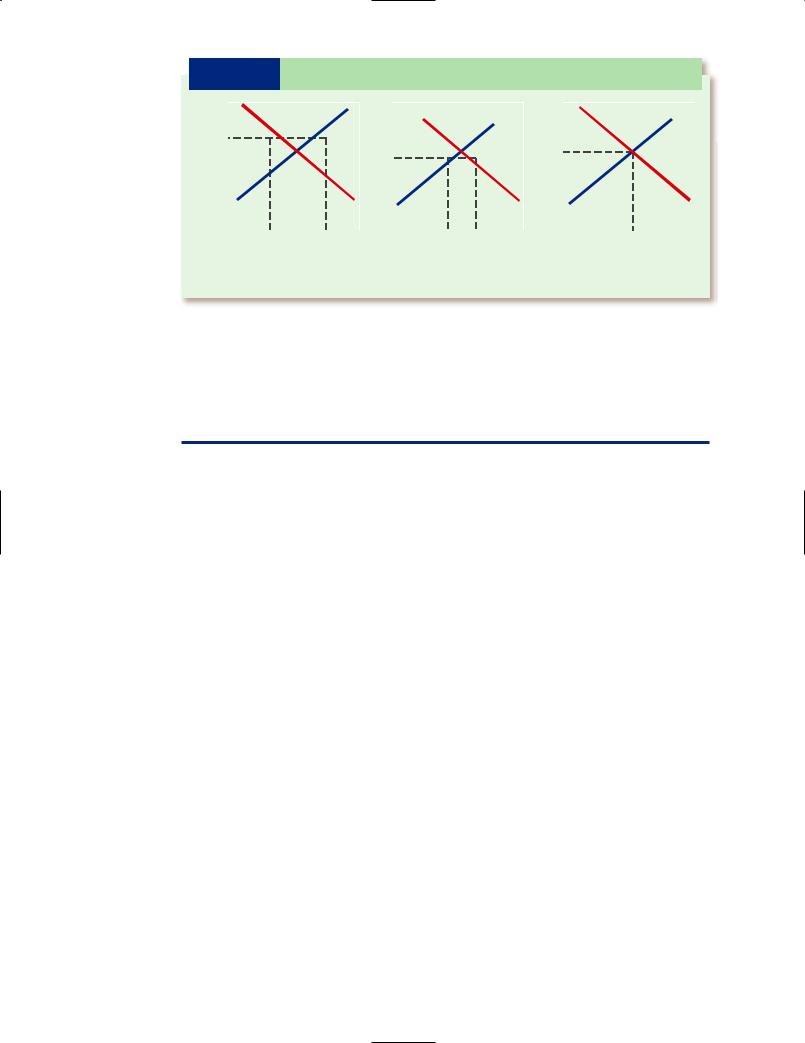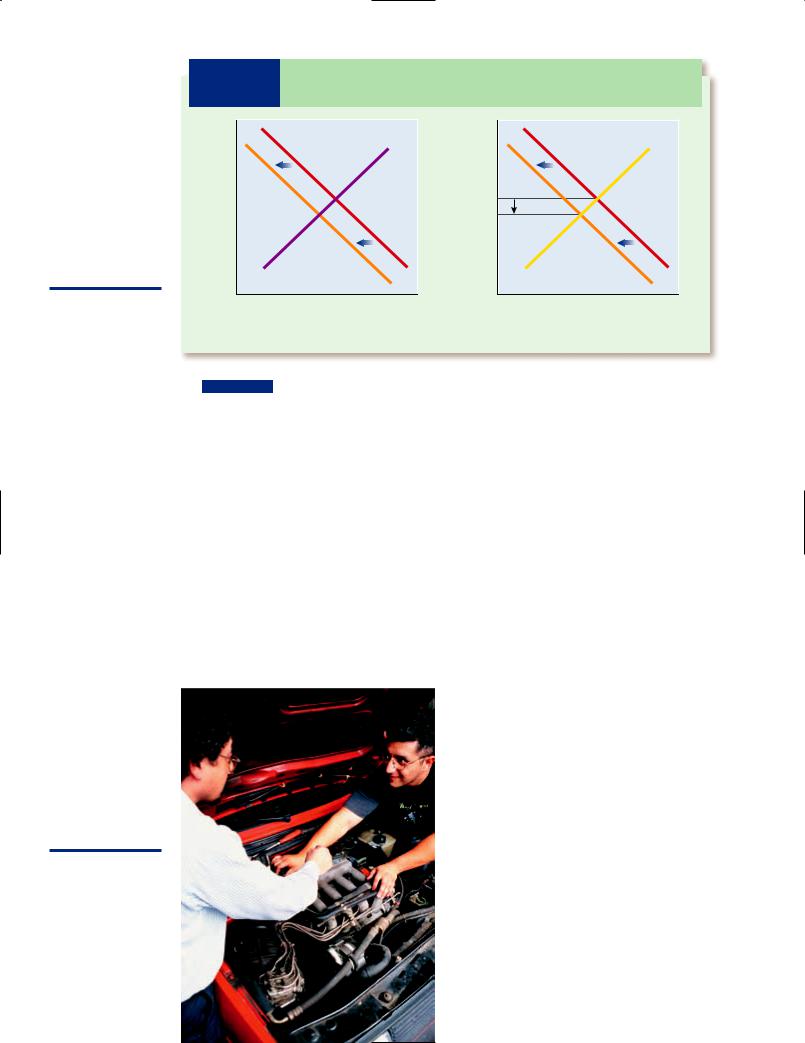
Economics_-_New_Ways_of_Thinking
.pdf
What Determines
Wages?
Focus Questions
What does the demand curve for labor look like?
What does the supply curve for labor look like?
Why do wage rates differ?
What are nonmoney benefits and how do they factor into comparisons between jobs?
What factors will determine how much you will earn?
wage rate
The price of labor.
Supply and Demand in the
Labor Market
In Chapters 4 and 5 you learned about demand and supply. In particular, you learned how both supply and demand affect prices for goods or products—such things as apples, cars, and houses. Supply and demand can also be used to analyze how we determine the price of a resource, or factor of production, such as labor.
People who demand labor are usually referred to as employers, and people who supply labor are employees. Looking at employers and employees in this way, we can create a demand curve and a supply curve showing the price of labor. The price of labor is called the wage rate.
The demand curve for labor is downward sloping (left to right), as shown in Exhibit 9-1. A downward-sloping demand curve indicates that employers will be willing and able to hire more people at lower wage rates than at higher wage rates. For example, employers are willing and able to hire more workers if the wage rate is $7 per hour than if the wage rate is $10 per hour.
Jack owns a small hotel. Currently, he employs four persons to clean rooms. He pays each person $80 a day. If he could pay each worker only $60 a day, he would hire five instead of four persons to clean rooms.
The supply curve for labor, in contrast, is upward sloping (left to right), as shown in Exhibit 9-2. More people will be willing and able to work at higher wage rates than at lower wage rates. In the exhibit, more people are willing and able to work if the wage rate is $10 per hour than if the wage rate is $7 an hour. For example, Pam is not willing to work as a salesperson in a clothing store if the store pays $7 an hour. However, she is willing to work as a salesperson in a clothing store if the store pays $10 an hour.
How the Equilibrium Wage
Rate Is Established
Recall from Chapter 6 that the equilibrium price is the price at which the quantity demanded of a good equals the quantity supplied. Suppose $14 is the equilibrium
224 Chapter 9 Labor, Employment, and Wages

E X H I B I T 9-1 The Demand for Labor
Demand for
gratee |
labor |
|
$10 |
||
|
||
Wa |
$7 |
|
|
E X H I B I T 9-2 The Supply of Labor
Supply of labor
gratee |
$10 |
|
|
Wa |
$7 |
|
|
|
Number of |
|
|
|
|
|
|
|
Number of |
|
|
|
|
|
Number |
|
|
|
|
|
|
Number |
|
|
|||||||||||||||
|
|
|
|
|
|
|
|
|
|
|
|
|
|
|
|
|
|
|
|
|
|
|
|
|
|
|
|
|
|
|
|
|
|
|
|
|
|
|
||
workers |
workers |
of workers |
of workers |
|||||||||||||||||||||||||||||||||||||
|
|
|
|
|
|
|
|
|
|
|
|
|
|
|
|
|
|
|
|
|
|
|
|
|
|
|
|
|
|
|
|
|
||||||||
employers |
employers |
willing and |
willing and |
|||||||||||||||||||||||||||||||||||||
|
|
|
|
|
|
|
|
|
|
|
|
|
|
|
|
|
|
|
|
|
|
|
|
|
|
|
|
|
|
|
|
|
||||||||
are willing |
are willing |
able to |
able to |
|||||||||||||||||||||||||||||||||||||
|
|
|
|
|
|
|
|
|
|
|
|
|
|
|
|
|
|
|
|
|
|
|
|
|||||||||||||||||
and able to |
and able to |
work at |
work at |
|||||||||||||||||||||||||||||||||||||
|
|
|
|
|
|
|
|
|
|
|
|
|
|
|
|
|
|
|
|
|
|
|
||||||||||||||||||
|
|
hire at $10 |
hire at $7 |
|||||||||||||||||||||||||||||||||||||
|
|
|
|
|
|
|
|
|
|
|
|
|
$7 per |
$10 per |
||||||||||||||||||||||||||
|
|
|
|
|
|
|
|
|
|
|
|
|
|
|
|
|
|
|
|
|
||||||||||||||||||||
|
|
per hour |
per hour |
hour |
hour |
|||||||||||||||||||||||||||||||||||
|
|
|
|
|
|
|
|
|
|
|
|
|
|
|
|
|
|
|
|
|
|
|
|
|
|
|
|
|
|
|
|
|
|
|
|
|
|
|
|
|
A downward-sloping demand curve indicates |
|
An upward-sloping supply curve indicates |
that employers hire more people at lower |
|
that more people are willing and able to work at |
wage rates. |
|
higher wage rates. |
|
|
|
price of compact discs; at this price, the number of compact discs that sellers are willing and able to sell equals the number of compact discs that buyers are willing and able to buy.
Similarly, in the labor market, the equilibrium wage rate is the wage at which the quantity demanded of labor equals the quantity supplied of labor. Stated differently, it is the wage rate at which the number of people employers are willing and able to hire is the same as the number of people who are willing and able to be hired. In Exhibit 9- 3(a) on the next page, when the wage rate is $9, the number of people who are willing and able to work (quantity supplied equals 7,000) is greater than the number of people employers are willing and able to hire (quantity demanded equals 3,000). It follows that $9 is not the equilibrium wage rate; at $9, the market has a surplus of labor.
In Chapter 6, you learned that when a surplus of a good occurs, the price of the
good falls. Things are similar in a competitive labor market. When the market has a surplus of labor, the wage rate falls:
Quantity supplied of labor > Quantity demanded of labor Surplus of labor
Surplus of labor → Wage rate falls
Now consider Exhibit 9-3(b). The wage rate is $7, and the number of people employers are willing and able to hire (6,000) is greater than the number of people who are willing and able to work (4,000). Thus, $7 is not the equilibrium wage rate. At $7, the market experiences a shortage of labor, so the wage rate rises:
Quantity demanded of labor > Quantity supplied of labor Shortage of labor
Shortage of labor → Wage rate rises
Section 1 What Determines Wages? 225

E X H I B I T 9-3 Finding the Equilibrium Wage Rate
Wage rate
|
|
S |
|
|
S |
|
S |
|
|
|
|
|
|
||
|
|
|
|
|
|
|
|
$9 |
|
|
|
|
|
|
|
|
|
|
$7 |
|
|
$7.75 |
|
|
|
|
|
|
|
|
|
|
|
D |
|
|
D |
|
D |
|
|
|
|
|
|
|
|
0 |
3,000 |
7,000 |
0 |
4,000 |
6,000 |
0 |
5,000 |
|
Number of workers |
|
Number of workers |
|
Number of workers |
||
|
|
(a) |
|
(b) |
|
|
(c) |
(a) At $9 per hour, the number of people willing and able to work (7,000) is greater than the number employers are willing and able to hire (3,000). We conclude that $9 is not the equilibrium wage rate. (b) At $7 per hour, the number of people employers are willing and able to hire (6,000) is greater than the number willing and able to work (4,000). We conclude that $7 is not the equilibrium wage rate. (c) At $7.75 per hour, the number of people willing and able to work (5,000) is the same as the number employers are willing and able to hire (5,000). We conclude that $7.75 is the equilibrium wage rate.
In Exhibit 9-3(c), the wage rate is $7.75, and the number of people employers are willing and able to hire (5,000) equals the number of people who are willing and able to work (5,000). We conclude that $7.75 is the equilibrium wage rate. At this level the wage rate neither rises nor falls because the market has no shortage or surplus of labor.
Why Do Some People Earn More than Others?
If you convert a daily salary or a monthly salary into hours, you can find out how much a person earns on an hourly basis. This figure is that person’s wage rate. For example, suppose someone earns $4,000 per month and works 160 hours a month. Her wage rate is $25 an hour.
Now some people earn a higher wage rate than others. For example, some people earn $100 an hour while other people earn $8 an hour. Why the big difference? Supply and demand help us to understand why some people earn higher wages than
others. First, suppose that the demand for every type of labor is the same—the demand
for accountants is the same as the demand for construction workers, and so on. Now suppose we learn that the equilibrium wage rate for accountants is higher than that for construction workers. If demand for the two types of labor is the same, how can we explain the difference in wage rates? Obviously, the supply of accountants and the supply of construction workers must not be the same. If accountants earn more than construction workers, it must be because the supply of accountants is less than the supply of construction workers. We conclude that wage rates can differ because the supply of different types of labor is not the same.
Suppose instead that the supply of different types of labor is the same—for example, suppose the supply of bank tellers is the same as the supply of grocery store cashiers. If grocery store cashiers earn more than bank tellers, then what could possibly explain the difference? Obviously, the demand for bank tellers and grocery store cashiers must not be the same. We conclude that wage rates can differ because the demand for different types of labor is not the same.
As an aside, you may be interested in knowing the average hourly earnings of
226 Chapter 9 Labor, Employment, and Wages

workers in different industries. In 2003, in construction it was $18.95; manufacturing, $15.74; financial activities, $17.13; leisure and hospitality, $8.76; and business and professional services, $17.20.
QUESTIONS: Many physicians earn less than many major league baseball players, but shouldn’t they earn more? After all, major league baseball players are just playing a game. At least some physicians are saving lives.
ANSWER: Your question takes us beyond the confines of economics. It’s sort of like asking a physicist if we would be better off if dynamite didn’t blow up. Some things just are. It is a fact that the average major league baseball player earns more than the average physician, and it is not so much the economist’s job to pass judgment on this point, as it is to explain why. Addressing the “why part” has to do with supply and demand. If a lot more people could do what major league baseball players do (a lot more supply of major league baseball players), you can be sure they would earn less than they currently do. Or, if, for example, people stopped watching baseball games (the demand for baseball games falls off), baseball salaries would decline. As things are now, though, the demand for baseball players is high and the supply of them is low, and so they earn more than most people earn.
Are Money Benefits the
Only Thing That Matters?
Suppose Smith is offered two jobs, A and B. In job A, he will earn an annual income of $100,000 and in job B, $40,000. Which job will he choose? Most people would say that he will choose job A because it pays a higher income. Smith won’t necessarily choose job A, however, because a higher income (more money per year) is not the only thing that matters to people. Also important are what people are doing in their jobs, who their
coworkers are, where they have to work, how many hours a week they have to work, how much vacation time they receive, and more. In short, if everything between the two jobs, A and B, is the same except that job A pays $100,000 and job B pays $40,000, then certainly Smith will choose job A over job B. However, usually not everything is the same between two jobs.
Let’s suppose that Smith chooses job B (the lower-paying job) over job A. He tells us that he chose the lower-paying job because he likes the job so much more. In job B he is doing something that he has always wanted to do, he works with nice people, he gets one month of vacation each year, and he is enormously stimulated by what he does. In contrast, in job A he would have been doing something both boring and tedious to him, he would have worked with people he did not really like (especially his boss), and he would have had only two weeks of vacation each year. On top of all this, he would have had to work 10 hours more each week in job A than he has to work in job B, and he would have had much less job security. Thus, job A pays more than job B, but job A does not have the nonmoney benefits that job B has.
All jobs come with both money benefits and nonmoney benefits. Look at it this way:
Benefits in a job
Money benefits (income) Nonmoney benefits
Being able to afford a trip to a seaside resort is of no value if your job prevents you from getting away. What are some nonmoney benefits of a job?
Section 1 What Determines Wages? 227

Do You Want the 1st or the 43rd Pick in the NFL Draft?
??????????????????
Each year the National Football League (NFL) conducts a
draft in which the 32 teams take turns picking the best college players. Most people assume that the players picked earlier are the better football players. For this reason, where a player is picked in the draft largely determines that player’s starting salary: the earlier chosen, the higher the salary.
After studying the NFL draft, two economists argue that how valuable a player is to a team depends on how productive the player is, and how much he is paid. For example, player 1 might perform better than player 2, but be paid twice as much as player 2. But unless
player 1 is twice as valuable on the field as player 2, then either he is being “overpaid” or player 2 is being “underpaid.”
The economists collected data from the last 17 drafts and tried to figure out which draft picks were the “best” for the amount of money they were paid. The economists tried to identify not the best overall
player, but the “best per dollar” player.
What did they discover? The best per dollar player is not usually the first pick in the first round. Instead, the best pick per dollar is usually the 43rd person picked, which is the 11th pick in the second round. In 2004, this pick went to the Dallas Cowboys, who took running back Julius Jones. Jones ran for 819 yards and scored seven touchdowns in eight games. Cost to Dallas for Jones’s six-year contract: a very reasonable $4.37 million (the first pick that year, Eli Manning, received
asix-year, $54 million contract). The strategy outlined by the economists—go with
lower-priced players in the second round rather than higher-priced players in the first round— is said to have been the strategy employed by General Manager Bobby Beathard of the Washington Redskins in the 1980s. He often traded away his firstround picks for lowerpriced picks in later
rounds. The team Beathard built using this strategy won three Super Bowls. In more recent years, the New England Patriots won three Super Bowl titles in four years led by quarterback Tom Brady, who wasn’t drafted until the sixth round.
So, if the economists are right, why are many teams paying too much for some of the early picks in the draft? Some have speculated
that it is difficult to correctly estimate an athlete’s worth over time, as compared to other types of employees. For example, could you estimate a typist’s productivity over time? A typist who types 60 words this year is likely to type 60 words next year and 60 words the year after. His or her work environment and skills might improve modestly, but will probably be fairly constant from one year to the next.
The productivity of football players, on the other hand, seems to be very different. A football player usually plays with different team members and for different coaches from one year to the next, both of which impact the player’s performance.
It is also the case that injuries and age can have a major impact on a player’s performance, much more significantly than in other occupations.
Since the two economists published their research, a number of NFL teams have contacted them for advice. It will be interesting to see which teams, if any, continue to overpay top picks. And by the way, how has your favorite team done in recent drafts?
We might expect that in some fields produc-
tivity is more closely linked to pay than in other fields. For example, we would expect it to be closely linked in a field where it is easy to measure productivity and less closely linked in a field where it is hard to measure productivity. In what fields do you think it might be hard to measure productivity?
228 Chapter 9 Labor, Employment, and Wages

Certainly job A comes with higher money benefits (higher income) than job B, but (as far as Smith is concerned) it also comes with lower nonmoney benefits than job B. Because Smith chose job B (the $40,000 job) over job A (the $100,000 job), the nonmoney benefits in job B must have been higher than the nonmoney benefits in job A.
How much higher must they have been, in a dollar amount? The answer is at least $60,000 higher. To understand why, consider what Smith has “paid” by choosing job B over job A. He has paid $60,000 a year, because he has given up the opportunity to earn $60,000 more a year in job A. Therefore, the nonmoney benefits of job B must have been worth at least $60,000 to Smith. This means that job B “pays” more, as long as we understand that a person in a job is paid in terms of both money and nonmoney benefits.
 Kevin graduates from college in a year. His father has always wanted him to go to medical school. One of the reasons his father wants him to go to medical school is because doctors earn a relatively high salary. An orthopedic surgeon, for example, can earn $600,000 a year. Kevin doesn’t really want to go to medical school. It’s not that he thinks he would find being a doctor uninteresting, it’s just that he doesn’t want to work as hard as one needs to work to become a physician. He would have to go to four years of medical school, then serve an internship and residency, then, perhaps, end up working 60 to 80 hours a week for years. According to Kevin, “There is more to life than just money.”
Kevin graduates from college in a year. His father has always wanted him to go to medical school. One of the reasons his father wants him to go to medical school is because doctors earn a relatively high salary. An orthopedic surgeon, for example, can earn $600,000 a year. Kevin doesn’t really want to go to medical school. It’s not that he thinks he would find being a doctor uninteresting, it’s just that he doesn’t want to work as hard as one needs to work to become a physician. He would have to go to four years of medical school, then serve an internship and residency, then, perhaps, end up working 60 to 80 hours a week for years. According to Kevin, “There is more to life than just money.”
Here, then, is an example of a person who considers more than just the money benefits in a job; Kevin considers the nonmoney benefits too. Even though being a medical doctor comes with high money benefits, it doesn’t come with enough “nonmoney benefits” for Kevin. Obviously, Kevin is willing to trade off some money benefits he would receive as a doctor for greater nonmoney benefits in some other job.
ach year, Parade magazine Einterviews people in a variety
of jobs. It is mainly concerned with what people in various occupa-
tions earn. If you go to www.emcp.net/parade, you can see the wage rates for various occupations.
QUESTION: I thought economics was about money—specifically, the more money the better. Am I wrong here?
ANSWER: It is one thing to say “the more money the better” and quite another to say “the more money the better, all other things being equal.” The economist will make the second statement but not the first. In other words, what the economist means here is that if two jobs, A and B, are exactly alike except for the fact that job A pays more than B, then job A is a better job than job B.
The Demand for a Good and Wage Rates
Eva works in a radio factory. Suppose the demand for radios decreases as shown on the next page in Exhibit 9-4(a). What do you think will happen to Eva? If the demand for radios decreases, radio manufacturers do not need to hire as many workers, so the demand for workers decreases, as shown in Exhibit 9-4(b). As the demand for these workers decreases and the supply stays constant, the wage rate decreases.
Because the demand for labor is dependent upon the demand for the good or service labor produces, the demand for labor is often referred to as a derived demand. A derived demand is a demand that is the result of some other demand.
derived demand
A demand that is the result of some other demand.
Section 1 What Determines Wages? 229

The demand for radios affects the demand for the workers who produce the radios and their wages. In this example, when the demand for radios falls, the demand for workers also falls, causing wage rates to fall from $18 to $15 per hour.
E X H I B I T 9-4 The Demand for Radios, the Demand for the Workers Who Produce the Radios, and Their Wage Rates
|
S1 |
Price |
$18 |
$15 |
|
Wagerate |
|
|
D1 |
|
D2 |
Quantity of radios |
0 |
|
|
(a) Product market |
|
S1 |
D1 |
D2 |
Quantity of workers
(b) Labor market
How much do you think you would earn as an automobile mechanic? What are some of the
factors that would determine your wage rate?
Carl plays ice hockey. If the demand to watch ice hockey games falls (perhaps people switch from watching ice hockey to watching more basketball), then the demand for hockey players will fall too. As a result, Carl’s wage rate will fall.
What Will You Earn?
If you are reading this book as part of a high school course, you are somewhere between the ages of 14 and 18. Let’s jump ahead 15 years, when you will be between 29 and 33 years old. At that time, you will be working at some job and earning some wage rate or salary. You could be earning any-
where between, say, $20,000 and $500,000 a year. What will determine the amount you will earn?
Your wage rate (and salary) depends on a number of things, one of which is the demand for your labor services. The demand for you may be high, low, or medium. The higher the demand for you, the higher your wage rate will be. Obviously, you want the demand for you to be as high as possible.
Two factors will make the demand for your labor services high: (1) the demand for the good you produce, and (2) your productivity. The greater the demand for the product you produce, the greater is the demand for your labor services. If you produce attorney services and attorney services are in high demand, then you are in high demand, too. If you produce telephones and telephones are in low demand, then you will be in low demand, too.
The second factor that relates to the demand for you as an employee is your productivity. The more productive you are at what you do, the greater the demand for you. Suppose that two people can produce accounting services. One, however, can produce twice as many accounting services per hour as the other. It follows, then, that the faster accountant will be in greater demand by accounting firms.
A number of factors can influence your productivity. One factor is your innate abil-
230 Chapter 9

Are ?
Entertainers
Worth
Millions?
Atelevision news anchor announces a particular
sports star’s new salary: $10 million a year. The anchor goes on to say that a particular TV star will now earn $1 million per episode, and a movie star will get $20 million for his next movie.
When looking at these large salaries, it is natural to ask whether the people who receive them
are worth the money they are paid. Is anyone worth
$1 million per episode or $10 million to play one season of baseball?
Would an economist these high salaries are fied? Let’s explore the by laying out a possible of facts.
Suppose you are the president of NBC, and a star of one of your hit shows is asking for $1 million per episode. Whether you pay it depends on whether the star is worth $1 million per episode. But how do you determine whether she is worth $1 million?
First, you ask yourself what would happen to the ratings of the show if the star were no longer on it. Suppose you think the ratings would drop. If they dropped, you could not charge as much for a 30-second commercial. Currently, a 30-second spot on a top-rated television show sells for about $450,000. For 10 30-second commercials, the revenue is $4.5 million.
Suppose that without the star on the television show you think that
would reduce revenue to $2 million. In short, with the star the network earns revenue of $4.5 million an episode, and without the star it would earn revenue of $2 million per episode, a difference of $2.5 million. If the star left, revenue would drop by $2.5 million.
Is it worth paying $1 million to the star to prevent losing $2.5 million in revenue? The answer is yes. As long as the additional revenue that the star generates (in this case, an additional $2.5 million) is greater than the star’s salary (in this case, $1 million), then the star is worth what she is paid.
Sometimes a large difference separates what
a star earns from what others who work with the star earn. For example, in 2005, Shaquille O’Neal, who played with the Miami Heat (NBA basketball team) earned $30,466,072. Another player, Dorrell Wright, earned $1,032,200. What explains such a large difference between what a star earns and what those who work with the star earn?
ity; you may simply have been born with a great ability to organize people, play baseball, sing a song, or write a story. A second factor is how much effort you put into developing your skills. You may have worked hard developing and perfecting your ability to produce a service, whether it is attorney services, teaching services, or medical services. Third, your productivity is affected by the quality and length of your education. The higher the quality of your education
and the more education you have, the more productive you will be (all other things being equal). In fact, statistics show that as one’s educational level rises, so does one’s income. In summary, the demand for you (as an employee) will rise with the demand for the product or service you produce and your productivity.
Of course, your wage (or salary) in the future depends not only upon how high or low the demand for you is in the future but
Section 1 What Determines Wages? 231

Actress Kate Hudson attends a screening of
Elizabethtown
in Toronto in September 2005.
What qualities do you think contribute to Kate’s
earning more than most people her age?
minimum wage law
A federal law that specifies the lowest hourly wage rate that can be paid to workers.
also upon the number of people who can do what you do. In short, it also depends on supply. For example, the demand for you may be high, but if the supply is high too, you are not likely to earn a high wage. High wages are the result of high demand com-
bined with low supply.
Why is supply high in some labor markets and low in others? The supply of labor
offered in a particular labor market is the result of a number of factors, one of which is the ability to perform a particular service. For example, more people can work as restaurant servers than as brain surgeons. Similarly, more people can drive trucks than can argue and win difficult law cases before the U.S. Supreme Court. These statements do not put a value judgment on work as a restaurant server or truck driver. They simply report the fact that some tasks can be completed by more people than others. All other things being equal, the fewer people who can do what you do, the higher your wage (or salary) will be.
 Orthopedic surgeons earn a lot of money each year because they possess the three factors necessary to generate a high income. First, they are part of a (medical) team that produces health services, a service
Orthopedic surgeons earn a lot of money each year because they possess the three factors necessary to generate a high income. First, they are part of a (medical) team that produces health services, a service
that is in high demand. Second, orthopedic surgeons are productive. Third, not many people can do what they do (supply is low). In short, as was stated earlier, the combination of high demand for the good or service produced, high productivity, and a situation where not many people can do what one does, results in a high salary.
Government and the
Minimum Wage
The minimum wage law sets a wage floor—that is, a level below which hourly wage rates are not allowed to fall. The law, passed during the Great Depression of the
Every two years the U.S. Department of Labor publishes an interesting book titled the Occupational Outlook Handbook. You can see the most current edition of the book at www.emcp.net/jobs. If you are planning your work future, this book will be especially important to you. It identifies the median salary, job growth, and educational requirements of almost every job you can think of. Want to know how much a mathematician earns? Go to the handbook. Want to know what the educational requirements are for a teacher? Go to the handbook. Here are the 10 occupations that the Bureau of Labor Statistics predicts will be the fastest growing
during the period 2002–2012.
Growth rate (%) |
|
during the period |
|
Occupation |
2002–2012 |
Medical assistants |
59 |
Network systems and data |
|
communications analysts |
57 |
|
|
Physician assistants |
49 |
Social and human service |
|
assistants |
49 |
|
|
Home health aides |
48 |
Medical records and health |
|
information technicians |
47 |
|
|
Physical therapist aides |
46 |
Computer software |
|
engineers, applications |
46 |
|
|
Computer software engineers, |
|
systems software |
45 |
Physical therapist assistants |
45 |
232 Chapter 9 Labor, Employment, and Wages

This worker is paid the minimum wage at a sporting goods store near his home. How do you think he would be affected if the government raised the minimum wage by $2 an hour?
1930s, initially established a minimum wage of 25 cents an hour. In 2005, the federal minimum wage was $5.15 an hour. Some states, such as California, Washington, and Massachusetts, set their minimum wage rate higher than the federal rate. (An employee who is tipped, such as a restaurant server, is only required to be paid $2.13 an hour in wages if that amount plus the tips received equals at least the federal minimum wage. Also, a minimum wage of $4.25 per hour applies to young workers under the age of 20 during their first 90 consecutive calendar days of employment.)
The U.S. Congress determines the minimum wage. Earlier, however, you read that supply and demand determine wage rates. So what really does determine wage rates— the government or supply and demand? The fact is that supply and demand usually, but not always, determine wages.
Suppose that in a particular labor market the equilibrium wage rate is $4.10 an hour. In other words, the demand curve and the supply curve of labor intersect at a wage rate of $4.10. Congress then argues that a wage rate of $4.10 an hour is too low, and it orders employers to pay employees at least $5.15 an hour. This rate is now the minimum wage. It becomes unlawful to pay an employee less than this hourly wage.
Many people would agree with Congress that a wage of $4.10 an hour is simply too low. Economists, however, are not so interested in whether Congress is justified in setting a minimum wage as they are in knowing the effects of setting the minimum wage rate
above the equilibrium wage rate. They know what the intended effects are, but they also wonder about the unintended effects. For example, will employers hire as many workers at the minimum wage rate of $5.15 as they would at the equilibrium wage rate of $4.10? Remember, the demand curve for labor is downward sloping (from left to right). As the wage rate falls, employers will hire more workers; and as the wage rate rises, they will hire fewer workers. Thus, a minimum wage rate set by Congress above the equilibrium wage rate will result in employers being willing and able to hire fewer workers.
QUESTION: Without a minimum wage law, wouldn’t employers pay next to nothing for unskilled labor?
ANSWER: Suppose 100 people are working and earning the minimum wage of $5.15 an hour. First ask whether these people are worth $5.15 an hour. The answer has to be yes, because no employer would pay someone $5.15 an hour unless the employee was worth $5.15 an hour to the employer.
Now let’s ask ourselves whether the people who are not worth $5.15 an hour to an employer are working when the minimum wage is in existence. The answer is no. For example, Jack, 16 years old, may be worth $4.90 an hour, but not worth $5.15, so if the employer has to pay Jack $5.15 an hour he will not hire
Section 1 What Determines Wages? 233
